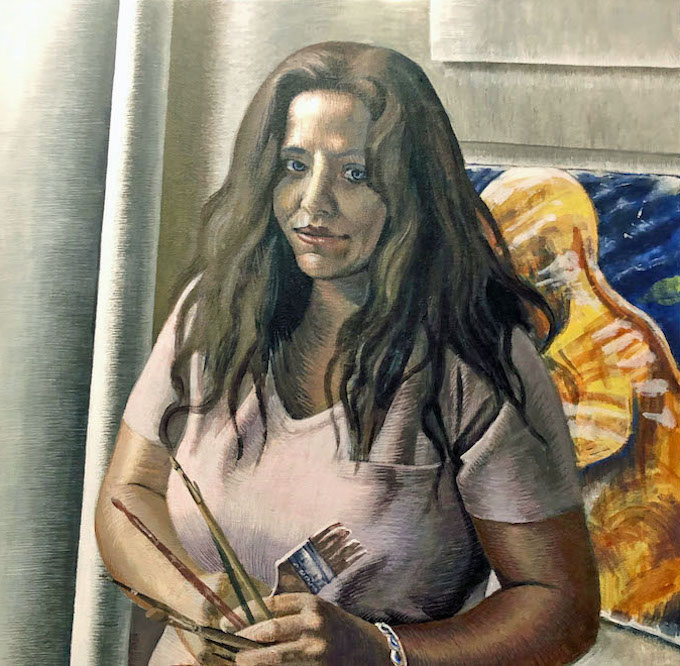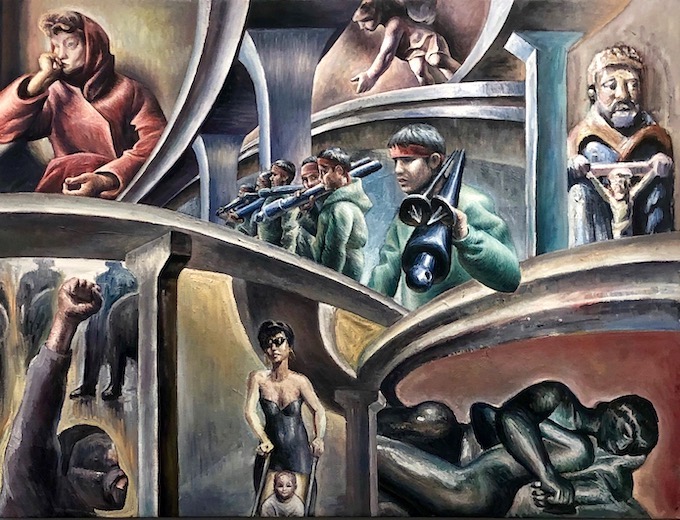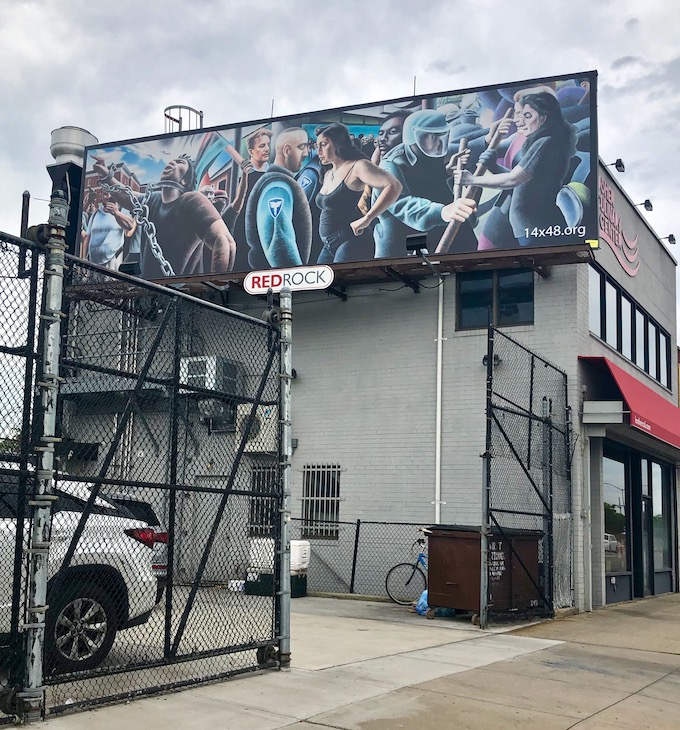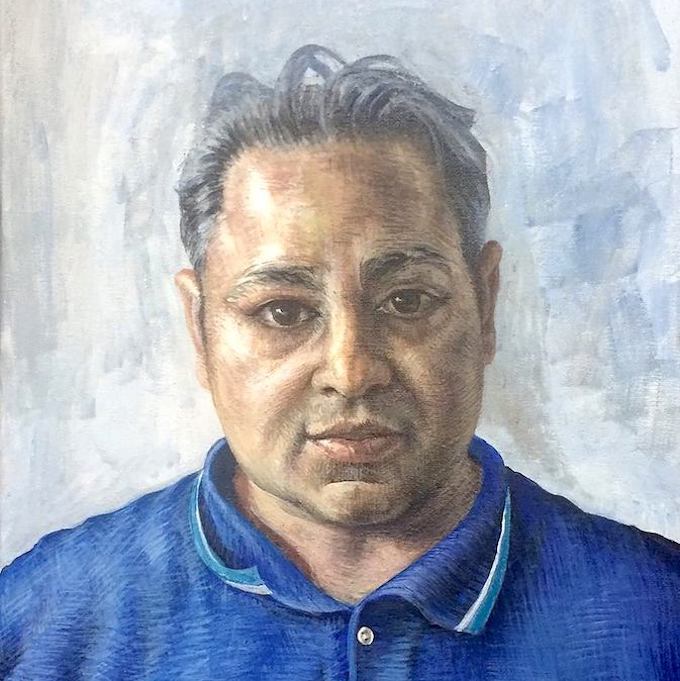After viewing his masterly works in several Fountain House Gallery exhibitions, I met the wonderfully talented artist Miguel Diego Colon at Fountain House Open Studio several months ago. Recently, I had the chance to find out a bit about him and view more of his artworks:
When did you first begin drawing?
I was four years old and in Pre-K. I was very shy —afraid of everybody. Drawing was how I could express myself, and everyone seemed to like my work. I still remember my Pre-K classmates imitating it.
What is your earliest art-related memory?
I saw an image of Thor, and felt that I, too, could do that. He was flying up to the heavens on a stormy day with his harness raised and his cape blowing in the wind.
And your first drawing?
I remember drawing Spiderman spinning a web and catching a spider.

Have you any favorite artists?
I have many. I especially like the American painter Eric Fischl. I like that everyone can read something different into his paintings. Other favorites include the European artists: Pierre Bonnard, Vincent van Gogh, Modigliani and Georg Baselitz. And the Mexican muralist Diego Rivera has been a particular inspiration.
What about cultural influences? Have any particular cultures or movements impacted or inspired your aesthetic?
I identify as Latino — as my family is from Puerto Rico — and I’m certain that has impacted my aesthetic. Among my primary influences are those people who fought against injustice — Martin Luther King…Malcolm X…Muhammed Ali. And movements of resistance such as Black Lives Matter.
How much time do you generally spend on a piece?
On the average — two to three months. I used to work on two to three pieces at once. But these days I tend to focus on one at a time.

What is your favorite work setting?
The Fountain House Studio I share with other Fountain House artists in Long Island City. I’m there three to four hours a day three or four times a week. I would spend more time in the studio if I could.
Have you any favorite media?
I like them all.
Have you any favorite colors? We’ve noticed you use blue a lot.
I like blue. It’s subtle — not too attention-grabbing.

Have you exhibited your work?
Yes. Among the spaces I’ve shown in are: SVA, NYU, the National Academy of Design, the Arts Students League, the Rush Arts Gallery, the Emerging Collector Gallery and here at Fountain House Gallery.
How important is the viewer’s response to your art?
It is important. I paint with a sense of what my work will mean to the viewer. That is my responsibility as an artist.
Are you generally satisfied with your final piece?
Not always.

Have you a formal art education?
I attended the High School of Art and Design, and I earned a BFA with Honors from the School of Visual Arts. I, also, studied at the Art Students League and worked at the National Academy of Design and New York Academy of Art.
Would you say your educational experience was worthwhile?
I have mixed feelings. I often felt that I was spinning my wheels trying to be a genius.
Do any particular teachers stand out?
Irwin “Greeny” Greenberg. While I was a student at Art & Design, I used to leave my house every morning — while it was still dark outside — to attend his painting class, the Old Hat Club that took place before the school day officially began. There I learned about light and dark and shadows. I became more interested in realism than in super heroes!

How has your aesthetic evolved through the years?
When I first began attending SVA, I thought about concentrating on animation. It seemed like a good career move — a way to make good money. But it wasn’t for me. I wanted to find my own voice, so I switched first to Illustration and then to Fine Art. Back at SVA, I experimented with figurative work and huge interiors with drips. Now my work is more community-based. My process is more thoughtful these days.
I first came upon your work at Fountain House Gallery. How did you hook up with Fountain House?
I was a patient at Gracey Square Hospital when I heard about Fountain House from one of the other patients there. That was in January 2018.
How has Fountain House impacted you?
It opened up an entire new world for me, and it has provided me with a studio to paint and a gallery to show my work. It has also provided me with a supportive community.
A huge powerful mural of yours — “Stand Up” — is now on view on a massive billboard on Flatbush Avenue near the Kings Plaza Shopping Center. I remember when you were still sketching segments of it. Can you tell us something about its theme? Its intent?
I was interested in creating a public mural that reflects the many forms of oppression that I have faced and observed in my community here in New York City. Among these are: the destructive forces of racism, sexism, inequality, and the stigma against those struggling with mental illness. It is my way of providing solidarity with others who are oppressed.
How were you able to access such a prominent space?
Betty Eastland, a peer-specialist and artist working at Fountain House Studio, had sent me a link to 14×48, a non-profit that repurposes vacant billboards as public art spaces. 14×48‘s mission is to create opportunities for artists to engage more with public art. I sent 14×48 a sketch, along with a proposal and examples of other paintings on the theme of social justice. I was amazed when I found out that I had been selected.
This was your first public mural. How have folks responded to it?
Everyone has been so supportive. The response has been overwhelmingly positive. I would love to create more work in public spaces. I think of this project as an audition to do more public works.

What do you see as the artist’s role in society?
To make a statement. That’s what art should do.
Where are you headed?
I don’t know. But I do know that I will continue painting. Painting is like prayer for me.
Interview conducted and edited by Lois Stavsky; Photos: 1 courtesy of the artist; 2-6 & 8 Lois Stavsky
Note: To find out more about the 14×48 billboard project, check here.

